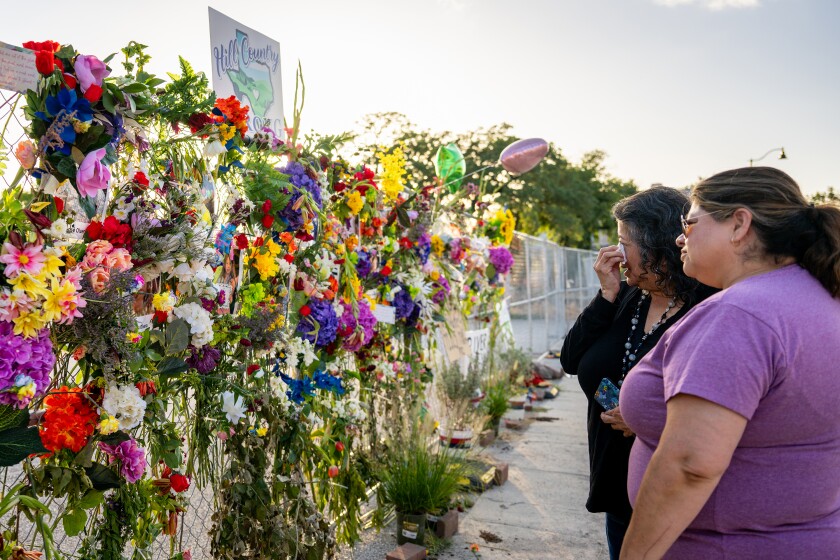In Brief:
- The Trump administration has made clear that it expects states to take on more of the cost burden of disasters.
- Disasters are more frequent and more costly, raising questions about states’ ability to meet the need.
- An analysis by the Pew Charitable Trusts provides a state-by-state look at the impact on state finances if the federal disaster aid they received had instead come out of their budgets.
Predicting when the next fire, flood or storm might strike isn’t the only challenge emergency managers face. There’s a new uncertainty: how the federal government will respond.
A review council led by Homeland Security Secretary Kristi Noem and Defense Secretary Pete Hegseth has until January 2026 to prepare recommendations for the future organization and function of the Federal Emergency Management Agency (FEMA).
Though President Donald Trump and Secretary Noem have both floated the idea of eliminating FEMA altogether, those following the work of the council don’t see things moving in that direction.
However, the new head of FEMA, David Richardson, has made it clear that states will be expected to share more of the cost of disaster response. A new analysis from the Pew Charitable Trusts takes a state-by-state look at how state finances would be affected if they had to cover disaster costs themselves.
The analysis compared fiscal year 2024 general fund spending, combined with reserves (rainy-day funds and excess dollars in general funds), to the highest amount of federal disaster aid a state had received since 2003.
The researchers found that, on average, the cost of the biggest past disasters had not been equivalent to a major portion of total state budgets. The numbers ranged from 0.02 percent in Arizona to 18.9 percent in Louisiana, they said.
Small as this share might be in some states, taking money out of the general fund budget means another state priority will lose support.
And the picture was very different when disaster costs were compared to reserves.
Under Water
Hurricane Katrina’s landfall in 2005 brought costs to Louisiana and Mississippi that exceeded 2024 reserves many times over — by 3,000 percent for Louisiana and almost 2,500 percent for Mississippi. Six states received one-year federal disaster aid that was equal to more than half of their reserves (over 90 percent in the case of Vermont).
This is not a static picture. Pew notes that state reserves have been inflated in recent years by pandemic-era federal programs. Rainy-day funds were 70 percent above FY 2019 levels. Cuts in federal funding, including money approved by Congress and since clawed back, will lead to both greater demand for reserves and shrinking balances.
It’s also apparent that past experience isn’t a reliable predictor of future disasters. Californians and Texans moved to Asheville, N.C., believing it to be a climate haven. Then flooding from Hurricane Helene washed buildings away and the debris that remained increased wildfire risk.
The size of Midwest territory at risk of damaging horizontal windstorms has increased by almost five times in recent decades. Extreme rain and destructive flash floods are becoming more common throughout the country.
The full cost of disasters to state and local governments is not well understood, says Peter Muller, a senior officer at Pew. “Spending on disasters happens before, during and after disaster strikes,” he says. It can involve agencies with responsibilities ranging from housing and public safety to forestry and transportation.
There may be more to learn, but Muller says there is a lot of evidence that the cost of disasters is increasing significantly over time for all levels of government. “There's a real need for states to be more proactive in how they're planning for those costs, and how they are investing in mitigation to reduce those costs over the long term,” he says.
Taken by Surprise
State and local governments will end up paying the costs of disasters one way or another, Muller says. The difference will be whether they build budgets that recognize these costs, or whether they’re taken by surprise, forced to scramble and readjust budget priorities.
Planning could involve dedicated disaster reserves or including disaster costs in long-term fiscal plans. Massachusetts has created a disaster relief and recovery fund, Muller says, designed to help local governments cover costs not covered by federal disaster declarations. (There’s a recent trend of denying or delaying these declarations, in keeping with the push for states to be solely responsible in more cases.)
California makes a wildfire budget based on the five years out of the last 10 in which the state spent the most on wildfire suppression. “Sometimes they overshoot, sometimes they undershoot,” Muller says. But the figure reflects real-world experience.
A 2020 report from Pew found that 46 states had disaster accounts of some kind, though contributions to them varied greatly. More than 20 identified disaster relief as an intended use for rainy-day funds. Every state has used legislative appropriations and agency budgets to cover disaster costs, but these can only go so far if the scale of need is great.
What Are the Biggest Risks?
Investing in community resilience when a flood or fire strikes is another rainy-day strategy. FEMA funded a 2019 study that found every dollar invested in mitigation can save up to $13 in response costs.
Following this, the agency provided money to states for mitigation projects until last April, when it announced the discontinuation of its Building Resilient Infrastructure and Communities program. More than $800 million was pulled back. Twenty states sued, and in August a federal court blocked the reallocation of these funds.
It’s unknown whether they will become available again, or if some form of this program will be included in FEMA legislation being considered by Congress. States will need to take the lead if federal funding for fire, storm and flood resiliency goes away for good.
“Mitigation is hard,” Muller says. “It’s always hard to break out of the year-to-year budget cycle to think about long-term investment in risk.” Still, he’s seeing signs that states understand the need.
He offers a starting point for moving this work forward: identify the biggest risks to a state’s residents and economy, then ask a question, “How can we prioritize the resources we have to reduce those risks most effectively?”
Related Stories















